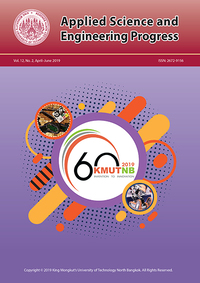Effect of Moisture Adjustment on Physico-chemical Properties, Durability and Production Efficiency of Broiler Feed Pellets
Main Article Content
Abstract
This study aims to investigate effect of moisture adjustment on physico-chemical properties, durability and production efficiency of broiler feed pellets. Three levels of moisture content (12, 13 and 14% wet basis) were adjusted by adding water at mixing step prior to pelletizing. The properties of pellets including moisture content, gelatinization behavior, pellet durability, density and length were determined. Moisture adjustment significantly increased moisture content of the final pellets (p < 0.05) but did not affect gelatinization behavior, pellet durability and density. The pellet length slightly decreased as the initial moisture content increased. Production efficiency was improved when increasing moisture content up to 14% while the quality of pellet remains the same. Thus, appropriate level of moisture adjustment at the mixing step could improve production efficiency of feed pellets.
Article Details
References
[2] Frost & Sullivan, “Independent market research on the animal farming industry in Thailand,” Frost & Sullivan, Shaw Tower, Singapore, 2014.
[3] GAIN Report, “Thailand poultry and products annual,” USDA Foreign Agricultural Service, USA, 2014.
[4] Aviatech, “The modern broiler requires optimal feed intake in order to support optimal and efficient growth,” Aviagen Incorporated, Alabama, USA, 2007.
[5] M. R. Abdollahi, V. Ravindran, T. J. Wester, G. Ravindran, and D. V. Thomas, “Effect of improved pellet quality from the addition of a pellet binder and/ormoisture to a wheat-based diet conditioned at two different temperatures on performance, apparentmetabolisable energy and ileal digestibility ofstarch and nitrogen in broilers,” Animal Feed Science and Technology, vol. 175, pp. 150–157, May 2012.
[6] California Pellet Mill Co. (2015, Sep.). The Pelleting Process. California Pellet Mill Co. California, USA [Online]. Available: http://www.cpm.net/downloads/Animal%20Feed%20Pelleting.pdf
[7] J. S. Moritz, R. S. Beyer, K. J. Wilson, and K. R. Cramer, “Effect of moisture addition at the mixer to a corn-soybean-based diet in broiler performance,” Poultry Science Association, vol. 10, pp. 347–353, 2001.
[8] J. S. Moritz, K. J. Wilson, K. R. Cramer, R. S. Beyer, L. J. McKinney, B. W. Cavalcanti, and X. Mo, “Effect of formulation density moisture, and surfactant on feed manufacturing, pellet quality, and broiler performance,” Poultry Science Association, vol. 11, pp. 155–163, 2002.
[9] M. R. Abdollahi, V. Ravindran, and B. Svihus, “Pelleting of broiler diets: An overview with emphasis on pellet quality,” Animal Feed Science and Technology, vol. 179, pp. 1–23, Oct. 2013.
[10] F. Zong-qiang, W. Li-jun, L. Dong, and A. Benu, “Effect of partial gelatinization on structure and thermal properties of corn starch after spray drying,” Carbohydrate Polymers, vol. 88, pp. 1319–1325, Feb. 2012.
[11] H. Jovin, L. Enpeng, and D. Sushil, “Milling of rice grains: Effect of starch/flour structure on gelatinization and pasting properties,” Carbohydrate Polymers, vol. 92, pp. 682–690, Sep. 2013.
[12] ASAE Standard, Cubes, Pellets and Crumbles-Definitions and Methods for Determining Density, Durability and Moisture Content, ASAE S269, 1996.
[13] K. Apoorva, Y. Hojae, and M. P. Virendra, “Fundamental mechanical properties of ground switchgrass for quality assessment of pellets,” Powder Technology, vol. 283, pp. 48–56, May. 2015.
[14] B. Svihus, K. H. Kløvstad, V. Perez, O. Zimonja, S. Sahlstrom, R. B. Schuller, W. K. Jeksrud, and E. Prestløkken, “Physical and nutritional effects of pelleting of broiler chicken diets made from wheat ground to different coarsenesses by the use of roller mill and hammer mill,” Animal Feed Science and Technology, vol. 117, pp. 281–293, Aug. 2004.
[15] G. L. Martin, E. N. Michael, K. E. Bjarne, and F. Stina, “Image analysis of pellet size for a control system in industrial feed production,” Journal of PLOS ONE, vol. 6, pp. 1–10. 2011.
[16] E. R. Skoch, K. C. Behnke, C. W. Deyoe, and S. F. Binder, “The effect of steam-conditioning rate on the pelleting process,” Animal Feed Science and Technology, vol. 6, pp. 83–90, Oct. 1981.
[17] J. S. Moritz, K. R. Cramer, K. J. Wilson, and R. S. Beyer, “Feed manufacture and feeding of rations with graded levels of added moisture formulated to different energy densities,” Poultry Science Association, vol. 12, pp. 371–381, 2003.
[18] F. L. Norman and W. E. Marshall, “Differential scanning calorimetry of whole grain milled rice and milled rice flour1,” Cereal Chemistry, vol. 66, pp. 317–320, Oct. 1989.
[19] K. K. Lundblad, J. D. Hancock, K. C. Behnke, E. PrestlØkken, L. J. McKinney, and M. SØrensen, “The effect of adding water into the mixer on pelleting efficiency and pellet quality in diets for finishing pigs without and with use of an expander,” Animal Feed Science and Technology, vol. 150, pp. 295–302, Oct. 2009.
[20] O. Zimonja and B. Svihus, “Effects of processing of wheat or oats starch on physical pellet quality and nutritional value for broilers,” Animal Feed Science and Technology, vol. 149, pp. 287–297, Jun. 2009.
[21] M. Thomas and A. F. B. van der Poel, “Physical quality of pelleted animal feed 1. Criteria for pellet quality,” Animal Feed Science and Technology, vol. 61, pp. 89–112, Dec. 1996.
[22] A. S. Parsons, N. P. Buchanan, P. K. Blemings, M. E. Wilson, and J. S. Moritz, “Effect of corn particle size and pellet texture on broiler performance in the growing phase,” Poultry Science Association, vol. 15, pp. 245–255, 2006.
[23] W. H. Hasting and D. Higgs. (2015, Sep.). Feed Milling Processes. Food and Agriculture Organization of the United Nations. Rome, Italy [Online]. Available: http://www.fao.org/docrep/x5738e/x5738e0j.htm


